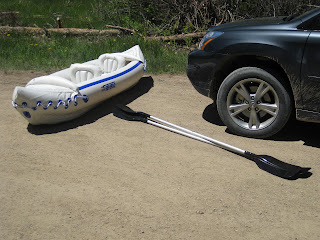
Saturday, June 27
After two days of rain, rain, rain, we finally saw the skies clear, and this is the morning view from the deck. We decided to try a new hike today. We're taking the Roaring Fork trail about 3 and half miles, and then connect to the Lake Watanga trail which in another mile and a half, will take us to Lake Watanga, at an altitude of 10,780 feet. Our trailhead begins at 8300 feet so we have an elevation gain of about 2500 feet. This trail lies in the Arapaho National Forrest, known as Indian Peaks. This part of the Arapaho lies about 15 miles southeast of the entrance to RMNP, and the trail system differs from RMNP, in that they allow dogs on the trails, and in general, the trails are not very well kept, and in places quite primitive.
We begin our hike at the Roaring Fork trailhead, the temperature being a cool 50 degrees, and immediately are faced with an uphill climb of 700 feet in the first half mile of the hike. The trail is very narrow and rocky, and a bit slippery from the recent rain.
 Once we have finished the initial chest pumping ascent, we find ourselves in a dense and lush forrest quite different from the forests in RMNP. This is almost rain forrest, with amazing greens and blues, with the occasional bright yellow flower peeking through the ground cover.
Once we have finished the initial chest pumping ascent, we find ourselves in a dense and lush forrest quite different from the forests in RMNP. This is almost rain forrest, with amazing greens and blues, with the occasional bright yellow flower peeking through the ground cover.
 Once we have finished the initial chest pumping ascent, we find ourselves in a dense and lush forrest quite different from the forests in RMNP. This is almost rain forrest, with amazing greens and blues, with the occasional bright yellow flower peeking through the ground cover.
Once we have finished the initial chest pumping ascent, we find ourselves in a dense and lush forrest quite different from the forests in RMNP. This is almost rain forrest, with amazing greens and blues, with the occasional bright yellow flower peeking through the ground cover.We can hear the thunder of rushing water, and soon find ourselves on the edge of the Roaring Fork creek, overflowing its banks.
Last year there was over 40 more inches of snow; however the rivers were not at as wild. The theory behind this, is that last year, the spring was rather warm, and dry, and so a lot of the snow evaporated. whereas, this year's spring has been rather damp and chilly, which has created a much larger run off. There are at places, precarious logs placed over the raging water, connecting one side of the trail to the next.


We continue to climb, as the trail winds around the river, which eventually flows all the way down the mountain to Lake Granby. At one point, the river has obliterated the trail.

After about 30 minutes of bushwhacking we find about a five foot space where we can jump across, and continue. We get to the Lake Watanga trail, and find small patches of snow, but nothing too deep or obstructive. However, after about a half mile up, we are stopped by our raging river again, which has made the final climb to Lake Watanga impassable. There is no way across, and the water is too deep and fierce to cross.

So, we are forced to turn around, and head home, all the while plotting our next attempt at this stunning trail in late July.



























